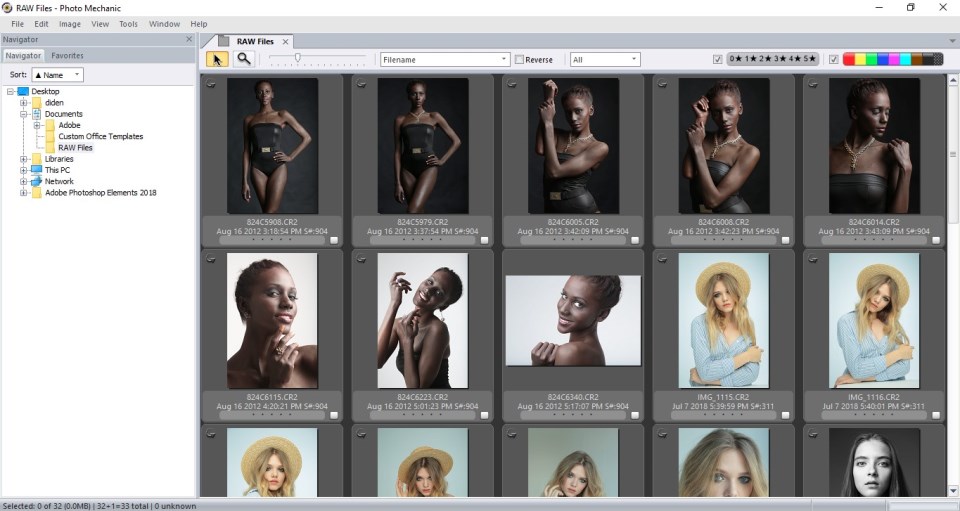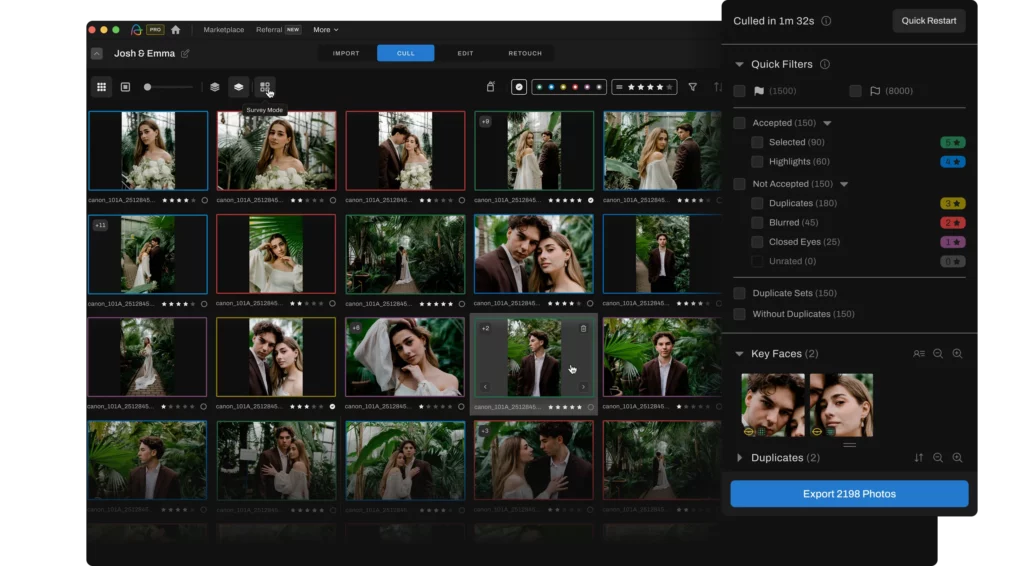Aftershoot vs Photo Mechanic: Which Culling Workflow Actually Saves You Time in 2026
A portrait photographer, Ernesto says in his Aftershoot vs Photomechanic breakdown video:
“Culling is one of the least fun but most important parts of photography.”
There’s no dearth of options for software made for culling photos. Even Lightroom recently released their AI culling feature to save photographers the time sink.
However, two tools have dominated that space for years: Photo Mechanic, the longtime industry workhorse, and Aftershoot, the AI-culling software. Both promise speed but in totally different ways. One gives you instant manual control while the other gives you hours of your life back.
This review breaks down how they stack up in real workflows and which one actually makes sense depending on how (and what) you shoot.
Aftershoot vs Photo Mechanic — Quick Comparison
| Feature | Photo Mechanic | Aftershoot |
| Culling Type | Manual | AI-assisted and AI-automated |
| Cull speed | Slow | Fast |
| Automation | None | Culling, Editing & Retouching |
| Learning Curve | Moderate | Minimal |
| Ideal For | Sports, Press, Agencies | Weddings, Portraits, Newborns (or any other volume photography) |
| Pricing Model | One-time ($130–230) | Starts at $10/month billed annually |
| Bonus Tools | Metadata & Code Replacements | AI Editing & Retouching |
| Workflow Goal | Speed + Control | Speed + Efficiency |
Video Review: Which Culling Tool Fits Your Workflow?
If you would rather watch a video, here’s a quick rundown on which culling tool fits your workflow
Here’s what Ernesto covers in this video
- Photo Mechanic loads RAW files instantly with no preview lag, that’s a huge jump from Lightroom-style rendering delays.
- Sports and photojournalism pros trust it because it handles metadata, code replacements, and batch renaming extremely fast.
- The downside is that it’s fully manual. You’re doing all the culling work yourself, and the UI feels dated compared to modern tools.
- Aftershoot uses AI to group similar shots, spot blinks and blurs, and suggest the sharpest keeper automatically. You can still review everything manually with intuitive review modes, but you start with a much smaller, cleaner set thanks to AI filtering.
- Aftershoot also handles AI editing based on your presets or past Lightroom catalogs, speeding up both culling and editing.
Why Photographers Are Choosing AI Culling in 2026
Our 2025 Photography Report found that 81% of photographers who adopted AI finally got their work–life balance back. And 62% are running hybrid workflows: AI for repetitive post-production tasks and their favorite software for the finishing touches.
Those extra hours go straight into client experience, business growth, or just… having a life.
You can dig into the full AI workflow insights inside our 2025 Photography Report.

Now let’s dig deeper into which tool is right for your workflow…
Photo Mechanic Review: Manual Culling Workflow
For two decades, Photo Mechanic has been the trusted companion for photographers who live by deadlines. It’s not fancy, but it works.
“You can start sorting without any annoying rendering delays.” — ShotVoice
If you shoot 20 frames of a basketball player mid-dunk and need the exact moment the fingertips graze the rim, PM opens that sequence instantly. There’s no preview lag, no waiting for Lightroom to catch up. You can compare frames side by side, rate them, tag keepers, and move on.
The multi-view mode (two to four images side by side) is built for exactly this.
And if you work with agencies or deliver caption-heavy files, PM’s metadata system is unmatched. IPTC templates, bulk renaming, code replacements, it’s the kind of nerdy workflow power most photographers love.
As Ernesto puts it in his review of the tool,
“It’s incredibly fast… but with Photo Mechanic, you’re still doing all the work.”
And that’s the core truth photographers keep repeating: Photo Mechanic gives you speed but not relief.
Key Features of Photo Mechanic
- Instant RAW browsing: Zero rendering delay.
- Metadata power: Apply IPTC templates, rename files, and embed codes for agencies or clients.
- Batch workflows: Great for bulk editing, captioning, or renaming entire folders of shots.
- Multi-view comparison: Compare up to four images to find the sharpest moment in a sequence.

Photo Mechanic Limitations
- Fully manual: every decision, every click, is on you.
- The interface feels dated, especially if you’re used to modern UI/UX.
- While it’s a one-time license, it’s not cheap ($130–$230 depending on version).
“The price scares away a lot of people.” — FixThePhoto
Yep, and this hits especially hard for wedding and portrait photographers. If you’re not using the metadata power features, paying $130–$230 for a manual culling tool starts feeling less like an investment and more like a punishment.
Photo Mechanic Limitations
It is built for control, so it's ideal for photographers who handle a limited number of images (between 50-100). If you shoot for agencies, deliver wire photos, or live in metadata, it’s unbeatable.
Aftershoot Review: AI-Powered Culling Workflow
Aftershoot takes the opposite route since it uses AI to do the boring part for you. Instead of manually rating every image, you import your folder and let it analyze the shoot automatically.
That’s exactly why so many high-volume photographers are looking beyond Photo Mechanic. One photographer summed it up perfectly
Key Features of Aftershoot AI Culling
Why photographers love Aftershoot’s AI culling:
- It detects blinks, blurs, and near-duplicates.
- Evaluates over 30 image attributes and groups similar shots and picks the sharpest, best-expression versions.
- Suggests highlights while keeping full manual control, if you want to review everything yourself.
- Learns from your selections every time you use it
You start with a curated batch of potential keepers and not 2,000 RAWs.

Additional Aftershoot Features
- AI editing: Learns from your Lightroom catalogs or presets.
- AI retouching: Clean up common retouching issues and distractions instantly
- Built for volume: Designed for wedding, portrait, newborn,and event photographers handling thousands of images weekly.
- Minimal learning curve: Intuitive from install to export.
- One flat fee
- No internet required, work from anywhere
Aftershoot Trade-offs
- AI editing profiles takes 2500+ images to train. (Use Instant AI profiles instead. If you just want to quickly try how it works, you can simply import your favorite Lightroom preset, edit 3 sample images, and try it on a full batch)
- Limited manual editing tools since it's focused on automation
Who Should Use Aftershoot?
Volume photographers such as wedding, portraits, newborns etc., who deal with thousands of images and want speed without burnout.
The Shift to AI Culling: What Photographers Are Saying
If Photo Mechanic represents the “manual but fast” era of culling, Aftershoot is the shift to software that takes work off your plate.
Across forums, reviews, and user groups, the feedback is consistent: photographers care about how they are spending their time on post-production. And clients’ expectations have changed rapidly. Sneak peeks within 24–48 hours are increasingly becoming the norm.
Our 2025 Photography Report found 28% of photographers now deliver full galleries within a week, up from just 13% the year before. Without some form of automation, that pace simply isn’t realistic.
And photographers who’ve already made the shift know. AI doesn’t replace you — it reduces the amount of tedious work you have to do. As one wedding photographer put it after using Aftershoot for 100+ weddings:
Aftershoot vs Photo Mechanic: Which Should You Choose?
At this point, the real choice isn’t “Which tool is faster?”
It’s which workflow makes sense for the way photographers work today. Photo Mechanic is still the gold standard for manual speed and metadata-heavy assignments. If you’re shooting sports sequences, wire service deadlines, or any job where you need pixel-level control over every frame, it remains a rock-solid tool.
But for most working photographers, especially weddings, portraits, newborns, and events, the bottleneck is still those micro decisions you need to make in your post-production process.
Aftershoot reduces the number of micro-decisions you’re forced to make and gives you a cleaner starting point.
If you’re still losing hours to culling every week, this is the moment to test a workflow built for how photographers actually work now—fast turnarounds, high volume, and a life outside your editing desk.
Try Aftershoot free and see how much time your next gallery actually takes. Because the tool you choose determines the time you get back.
